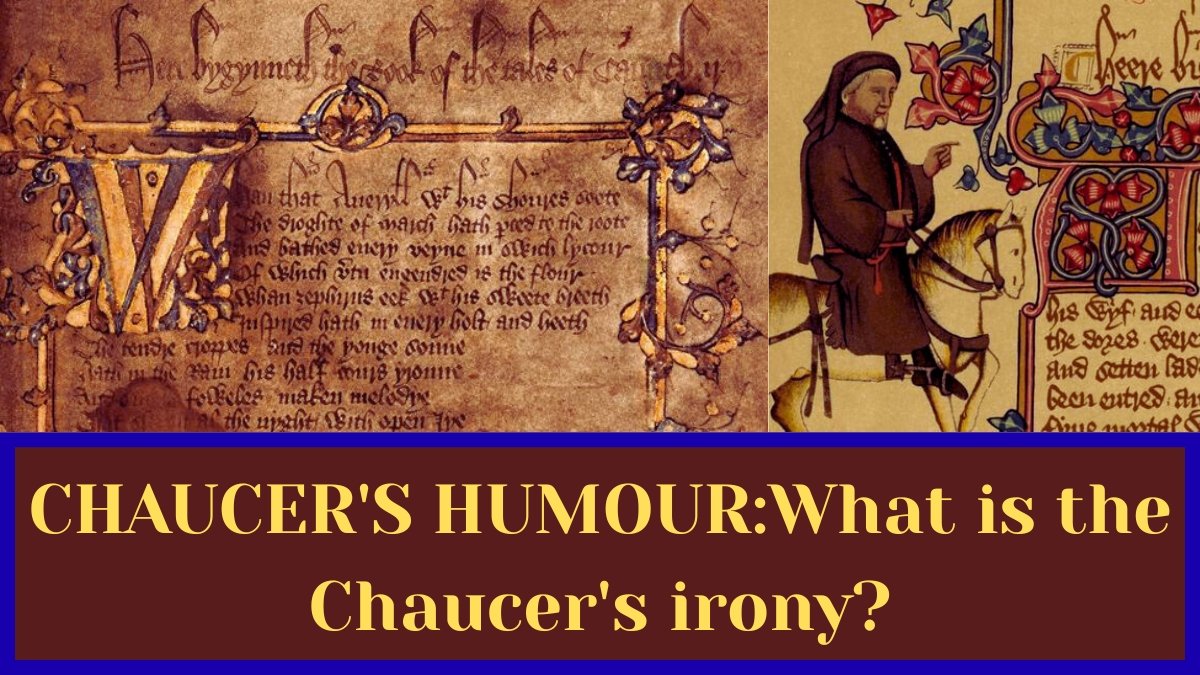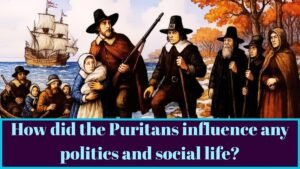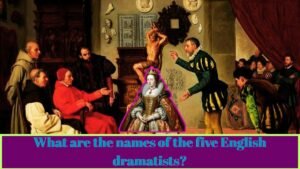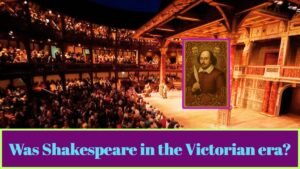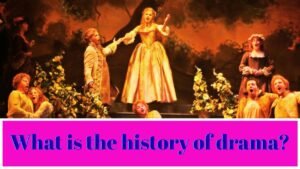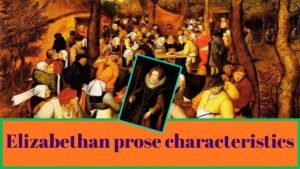CHAUCER’S HUMOUR:What is the Chaucer’s irony?
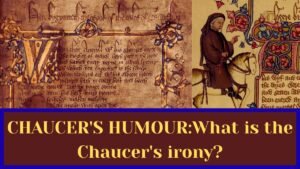
The most distinctive characteristic of Chaucer’s writings and specially of the Canterbury Tales is his humour. It is a pervasive quality and is found not only in the avowedly humorous tales but also in the serious ones. The humour is ironical er satirical, but neither the irony nor the satire is harsh. It is gentle and tolerant. Chaucer is always indulgent to the weaknesses of average humanity. Having nothing of the reformer in his composition he takes people as he finds them. This shows his understanding and wide sympathies. Being a realist he is impressed by the contrast between the ideal and the real and is content to paint the real. But we know from the realistic literature of the twentieth century how dull and drab realism can be. Chaucer’s realism is saved from this drabness by his good-natured humour. A keen observer and a kind critic he throws over his characters such a colouring of humour as to make them figures of romance.
We have seen this in his portraits of the Prologue. To illustrate his humour from the tales one would have to quote a greater part of the book. Still we may note the following examples:
(1) The Clerk’s Tale. He knocks the bottom off the idealistic tale of Griselda by making the clerk say at the end:
But O word, lordinges, herkeneth er I go (But one word, lords, listen before I go) It were ful hard to finde now a dayes
(It would be very hard to find now a days)
In al a toun Griseldes three or two (In all the town Griseldes three or two)
For, if that they were put to swich assayes (For if they were put to such assays or trials)
The gold of hem hath now so badde alayes (The gold of them hath now so bad alloys)
With bras, that though the coyne be fair at ye, (With brass, that though the coin be fair at all) It wolde rather breste a two than plye.
(It would rather break into two than bend).
And then how playful and mischievous is the irony of the advice offered to wives in the ‘Envoy’ (parting words).
Ye archewyves, stondeth at defence, (Ye arch wives stand at defence)
Sin ye be stronge as is a greet camille (Since you are strong as is a great camel)
Ne suffreth not that men yow doon offence. (No, suffer not men’s abuses)
An sclendre wyves, feble as in bataille (And slender wives too feeble to fight) Beth egre as is a tygre yond in Inde (Be fierce as an Indian tiger) Ay clappeth asa mill, I you consail. (Yes, be noisy as a mill, I counsel you)
(2) The Miller’s Tale. The miller’s words to the protesting Reeve:
An housbond shal not been inquisitif (A husband should not be inquisitive) Of goddes privetee, nor of his wyf (Of God’s secrets nor of his wife) So he may finde goddes foyson there. (So he may find God’s plenty there) Of the remenent nedeth nat enquere) (Of the remainder need not inquire)
(3) Sir Topas. The Host’s description of Chaucer:
‘What man artow? quod he; (What man art thou? said he;)
Thou lokest as thou woldest finde an hare (Thou lookest as thou wouldst find a hare) For ever upon the ground I see thee stare. Approche neer and loke up merily (Approach near and look up merrily) Now war you, Sirs, and lat this man have place (Now alert you. Sirs, and let this man have place) He in the waast is shape as wel as I (He in the waist is shaped as well as I) The host is broad of girth This were a popet in an arm t’enbrace (This would be a puppet (doll) in an arm to embrace) For any womman, smal or fair of face. He semeth elvish by his countenaunce (He seems elfish (ie. mysterious) by his countenance) For un-to no wight dooth he daliaunce. (For unto no person does he dalliance-‘talk’)
(4) The Monk’s Tale. The Host to the fat Monk:
I pray to god, yeve him confusion (I pray to God, give him confusion) That first thee broghte un-to religioun Thou woldest han been a trede-foul a right (Thou wouldst have been a copulating cock, all right) Haddestow as greet a leve, as thou hast might (Hadst thou as great a leave, as thou hast strength) To parfourne at thy lust in engendrure (To perform all thy lust in engendering) Thou haddest bigeten many a creature (Thou wouldst have begotten many a creature).
(5) The Wife of Bath’s Tale. In her Prologue she says that all the slanders on women have been written by Clerks or men of learning:
The clerk, whan he is old, and may noght do Of Venus werkes worth his old sho (The works of Venus (love-making) any more than his old shoe)
Than sit he doun and writ in his dotage
(Then sits he down and writes in his dotage) That wommen can not keep hir mariage (That women cannot keep their marriage (vows).
(6) The Summoner’s Tale. The Friar in the tale makes the astonishing discovery that Adam was driven out of Paradise on account of his gluttony!
Fro Paradys first, if I shal not lye
(From Paradise first, if I shall not lic) Was man out chaced for his glotonye (Was man driven out for his gluttony)
(7) The Merchant’s Tale. January’s preference for a young wife is delightfully witty:
But O thing warne I you, my freends dere (But one thing warn I you, my friends dear)
I wol non old wyf han in no manere (I will not old wife have in no manner)
She shal not passe twenty yeer, certayn Old fish and yong flesh wolde I have, ful fayn (Old fish and young flesh would I have full feign (most gladly)).
Chaucer’s Achievements.
The greatest achievement of Chaucer was that he was the first to introduce the note of modernity in English literature. Until his time literature had been medieval. It dealt either with ancient gods and heroes or with abstractions of the allegorical romance. Chaucer made a clean sweep of this unrealistic litter replacing it by real human beings and treating them in a spirit of kindly tolerance and humour, which is the modern way. Another achievement of his was the standardisation of the English language. In his time there were four dialects spoken in England: Northern, Southern, Fast Midland and West Midland. Of these the East Midland dialect, because it was spoken in and around London and in the University towns of Oxford and ford and Cambridge, tended to gain supremacy. Chaucer chose this for his writings with the result that it became the most popular of the dialects and in course of time the standard English language, the King’s (or Queen’s) English. When a great poet like Tulsidas chose the ‘Avadhi’ dialect of Hindi for his Ramayana, he raised it to the status of a national language. Chaucer did the same for the English language when he put the stamp of his approval on the East Midland dialect. This dialect was not rich, but Chaucer enriched it with his free borrowings and adaptations from French. In a sense he almost created the English language as we know it today.
The third achievement of Chaucer was in the sphere of versifica-tion. He discarded altogether the Anglo-Saxon alliterative tradi-tion “the rim, ram, roff”, as he calls it-and chose the regular, French metre and end rhyme. He wrote in three principal metres: the heroic couplet, the octosyllabic couplet and the Rhyme Royal stanza. In the heroic couplet, the main metre of the Canterbury
Tales, each line has ten syllables and five accents. The heroic couplet together with its later development, the blank verse or unrhymed decasyllabic line, became the most popular metre of later English poetry. The octosyllabic couplet, as its name implies, consists of rhyming lines, each of eight syllables with four accents. This is the metre of the Romance of the Rose and the Book of the Duchess. The Rhyme Royal stanza contains seven decasyllabic lines rhyming ababbcc. Chaucer used this stanza in the Parliament of Fowls and Troilus.
Thus we see that by choosing right subject, right language and right metre Chaucer put English literature on the road to modernity. His work is in every sense an introduction to English literature and he well deserves the title of father of English poetry.
How to read Chaucer.
We have said that Chaucer is in every sense modern. But this statement, so far as his language is concerned, is subject to certain qualifications. He is not modern in the same sense as Pope or Wordsworth. His language has certain difficulties inseparable from its origins. You will remember that Anglo-Saxon was a highly inflected language like modern German or Sanskrit. Over the years many of these inflections disappeared. The process began with the coming of the Danes and went on during the suppression of the native language after the Norman Conquest. Under the stress of necessity, namely that of facilitating communication between the Norman French conquerors and the masses, many of the trouble-some inflections were dropped, so that when the native English language ultimately emerged triumphant about the middle of the fourteenth century it was much simpler. But when Chaucer began to write, it still had old forms of words with inflections clinging to them. It is these words and inflections that are the stumbling blocks to the modern reader of Chaucer.
Let us take the first paragraph of the Prologue: Whan that Aprille
That ham hath helped n……………seke
We notice the following peculiarities:
(1) Many words ending in ‘e’-Aprille, sote, droughte, shoures, Marche, rote, etc.
(2) Different spellings-shoures (showers), sote (sweet), rote (root), swich (such), licour (liquor), flour (flower), strondes (strands), seke (seek), seke (sick) in the last line, etc.
(3) Inflected plural verbs – make, sleep, long, seek.
(4) Past participles with strange inflections-Y-ronne (run), holpen (helped).
(5) Minor peculiarities-‘hem’ for ‘them’, ‘hir’ for ‘their’
(6) Foreign or foreign looking words ‘Corages’, ‘ferne’, ‘halwes’, ‘couthe’.
What are the major characteristics of Chaucer’s style?
Of these the most important are the words ending in ‘e’, for on their proper pronunciation depends the rhythm of Chaucer’s lines. This final ‘e’ is always sounded if it occurs at the end of a line. If it occurs at the end of a word elsewhere, it is always sounded except when it is immediately followed by another vowel or ‘h’. The spellings and inflections present little difficulty and you get used to them. The foreign looking words, however, are foreign to the modern reader, for they are either Anglo-Saxon or French. But even these are really not so difficult as they appear. ‘Corages’ which suggests courage or courages is simply ‘hearts’, from the French ‘Coer’ meaning heart. The connection between courage and heart is obvious. ‘Ferne’ is Anglo-Saxon for ‘far off’, ‘halwes’ suggesting hallow, hallowed or holy is ‘saints’ from Anglo-Saxon halga holy. ‘Couth’ is Anglo-Saxon for ‘Known’. We are familiar with ‘uncouth’ uncivilised, clumsy.
Thus we see that differences between Chaucer’s English and modern English are not so great as they at first sight appear. At any rate the difficulty of language is not such as cannot be overcome with a little practice. The Concise Oxford Dictionary is about all one needs to get at the etymologies. Those who want greater assistance may read read Cha Chaucer’s Canterbury Tales side by side with a modernised version such as Nevill Coghill’s in Penguin classics.
Chaucer as a Social Historian.
On the basis of the living pictures of contemporary society con-tained in the Prologue, Chaucer has been described as a social historian. This statement, however, is only partially true. Chaucer has painted only the gay side of contemporary life turning a blind eye to its seamy side. No doubt he has pointed out the corruption in the Church in his satirical pictures of the fat friar, the hunting monk, the rascally Summoner and the greedy Pardoner, but in general he leaves the burning social and religious questions studious-ly alone. He says nothing about the widespread misery and devastation brought about by the Black death; the poverty and discontent of the masses, the Statute of Labourers, the high taxation, the extravagance and general misrule of Richard II; or the Peasants’ Revolt of 1381 and its cruel suppression. For all Chaucer cared these things had never been. The fact is that Chaucer was a court poet and not a poet of the people as Langland was. He wrote to amuse the court and the nobility, and being himself an easy going man who loved the good things of life did not bother to remind himself or others about the unpleasant aspects of life around him. If Gower, also a court poet, denounced the social evils that had brought about the Peasant’s Revolt, it was because his own vested interests as a landlord were threatened by the revolt. Lang- land was pauper priest with a missionary zeal. Hence his detailed descriptions and denunciations of social and religious evils of the time. Chaucer, on the other hand, was a realist to the core without any passion for reform. Being a keen observer he could not have failed to see the dark shadows in the life around him, but being at the same time a frank lover of life he turned his gaze away from them. Thus his social picture is one-sided and incomplete and his claim to being a social historian limited. In order to get a complete picture of the latter half of the fourteenth century Chaucer’s picture has to be supplemented by facets of life given by Langland and Gower.
PROSE OF THE AGE OF CHAUCER.
Besides the two prose tales-the tale of Melibee and the Parson’s tale-Chaucer wrote a Treatise on the Astrolabe, an astronomical instrument, which he dedicated to his little son Lewis and a trans-lation of Boethius. Chaucer’s prose is not so artistic as his verse and is unimportant. Wycliff’s Bible, the first vernacular translation of the scripture in Europe, made the holy book accessible to the common man and was the first step on the road to the Reformation. Its simple and forceful English demonstrated the potentialities of the vernacular in fields which were generally reserved for Latin. But the great prose work of this period was a book called Sir John Maundeville’s Travels. It is now generally believed that no such person as Sir John Maundeville ever existed, that the book is a translation from French, and that it is a compilation of fabulous tales from Pliny, Marco Polo and other purveyors of the marvellous. We are familiar with the character of “travellers’ tales”, and the book answers to the description to perfection. Most of the stories are purely mythical but nevertheless entertaining. We are told of birds that could carry off elephants in their talons, of weeping crocodiles, of a phoenix, of a valley full of devils jumping like grass-hoppers, and of a people who had only one leg but so big that it served them as an umbrella in the rainy season! The book is also remarkable for its literary style-simple, natural, and fluent. It was the most delightful book in English prose produced so far.
